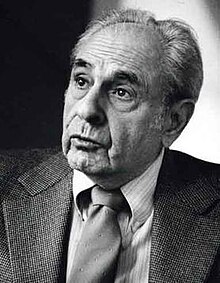
Back ألبرت شاتز (عالم) Arabic آلبرت شاتز AZB Алберт Шац (учен) Bulgarian Albert Schatz (Mikrobiologe) German Albert Schatz Spanish آلبرت شاتز Persian Albert Schatz (scientifique) French אלברט שץ HE ალბერტ შაცი XMF 艾伯特·沙茨 Chinese
Albert Schatz | |
|---|---|
 Albert Schatz | |
| Born | Albert Israel Schatz 2 February 1920 |
| Died | 17 January 2005 (aged 84) Philadelphia, USA |
| Alma mater | Rutgers University |
| Known for | Discoverer of streptomycin Deprived of credit for discovery, leading to change in US laws |
| Spouse(s) | Vivian Schatz (née Rosenfeld, married 1945) |
| Children | Linda Schatz Diane Klein |
| Awards | 1994 Rutgers University Medal |
| Scientific career | |
| Fields | Microbiology Science education |
| Institutions | Brooklyn College National Agricultural College in Doylestown University of Chile Washington University in St. Louis Temple University |
| Author abbrev. (botany) | A.Schatz |
Albert Israel Schatz (2 February 1920 – 17 January 2005) was an American microbiologist and academic who discovered streptomycin,[1] the first antibiotic known to be effective for the treatment of tuberculosis.[2] He graduated from Rutgers University in 1942 with a bachelor's degree in soil microbiology, and received his doctorate from Rutgers in 1945. His PhD research led directly to the discovery of streptomycin.
Born to a family of farmers, Schatz was inspired to study soil science for its potential applicability to take up his family occupation. Topping his class at Rutgers in 1942, he immediately worked under Selman Waksman, then head of the Department of Soil Microbiology, but was drafted to the US Army to serve in the World War II. After a back injury led to his discharge from the army, he rejoined Waksman in 1943 as a PhD student. Working in isolation from others due to his use of the dreaded tuberculosis bacterium (Mycobacterium tuberculosis), he discovered a new antibiotic which he named "streptomycin" that was proven safe and effective against the tuberculosis bacterium and other bacteria. He also contributed to the discovery another antibiotic albomycin in 1947.
The discovery of streptomycin led to controversies over its royalties from commercial production, and the Nobel Prize. Unbeknownst to Schatz, Waksman had claimed financial benefits only for himself and the Rutgers Research and Endowment Foundation. A lawsuit granted Schatz 3% of the royalties and legal recognition as the co-discover. Then, the 1952 Nobel Prize in Physiology or Medicine was awarded solely to Waksman explicitly "for his discovery of streptomycin,"[3] which The Lancet remarked as "a considerable mistake by failing to recognize Schatz's contribution."[4] As an act of goodwill, Schatz was honored with the Rutgers University Medal in 1994.
- ^ Zimmerman, Barry E., David J. (2002). Killer Germs (1 ed.). McGraw-Hill Education;(6 September 2002). p. 48. ISBN 978-0071409261.
{{cite book}}: CS1 maint: multiple names: authors list (link) - ^ Margalit Fox (2 February 2005). "Albert Schatz, Microbiologist, Dies at 84". The New York Times. Retrieved 17 August 2013.
- ^ Cite error: The named reference
:12was invoked but never defined (see the help page). - ^ The Lancet Infectious Diseases (2005-11-01). "The Nobel cause". The Lancet Infectious Diseases. 5 (11): 665. doi:10.1016/S1473-3099(05)70245-0. PMID 16253880.
© MMXXIII Rich X Search. We shall prevail. All rights reserved. Rich X Search